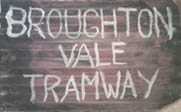 Layout
Tour
Layout
Tour  Layout
Tour
Layout
Tour
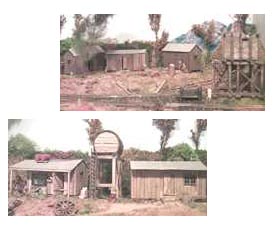
We start our layout tour at the layouts namesake area, Broughton Vale. This
logging camp was built completely on site by the lumber company. Although small
in size, the camp boasts three bunkhouses, a camp kitchen and dining room. From
right to left, the three bunkhouses are from Master Creations and John Rendall
kits. The Dining Room, Kitchen Water Tank, and Camp Kitchen were scratchbuilt
from wood by my best friend Nicole. Nicole's scratchbuilt Kitchen supply tank
is the first structure she had ever made. Details such as an interchangeable
menu board, ladies hanging washing out to dry, and four of the camp children
playing, are just a few of the eye catchers in these scenes.
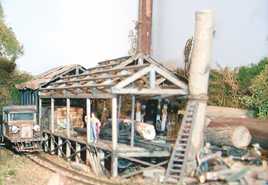 As we head out of town, our empty
log train passes the Broughton Vale Sawmill and Blacksmiths. The sawmill started
life as a Keystone Danby Sawmill, but was heavily modified to better represent
typical "bush architecture" and designs. Small Australian bush sawmills
were rarely enclosed, most getting by their entire working life with just enough
corrugated iron to to cover the expensive boiler, donkey engine, and saw carriage
machinery. The sawmill is the centrepiece of the camp, so almost everything
above the deck is scratchbuilt . This included the boiler, (equipped with fire
circuit in the firebox and Seuthe smoke machine in the chimney), donkey engine,
and the roof, which sports individual trusses, NBW detail, and all appropriate
overhead drive shafts and pulleys.
As we head out of town, our empty
log train passes the Broughton Vale Sawmill and Blacksmiths. The sawmill started
life as a Keystone Danby Sawmill, but was heavily modified to better represent
typical "bush architecture" and designs. Small Australian bush sawmills
were rarely enclosed, most getting by their entire working life with just enough
corrugated iron to to cover the expensive boiler, donkey engine, and saw carriage
machinery. The sawmill is the centrepiece of the camp, so almost everything
above the deck is scratchbuilt . This included the boiler, (equipped with fire
circuit in the firebox and Seuthe smoke machine in the chimney), donkey engine,
and the roof, which sports individual trusses, NBW detail, and all appropriate
overhead drive shafts and pulleys.
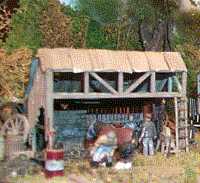 In
contrast with the sawmill, the Blacksmiths shop had very humble beginnings.
What started out as a Kibri European lumber drying shed from the scrap box,
had it's sides plated over with scale wood planks and it's "plastic trying
to be thatching" roof replaced with some scale wood roof beams, and scale
corrugated iron. Once weathered and surrounded with "junk", it fits
the bill perfectly. The tools and machinery inside are metal and plastic castings,
and the heath was fabricated out of leftover sections of plaster culvert. The
heath is equipped with a fire circuit which simulates the smoldering ashes used
by the blacksmith to heat metal parts for bending. Out the back of the shop
lies the remains of a vertical boilered skidder that has suffered a boiler explosion.
The basis of the model is a white metal sled from a small Keystone skidder,
while weathered aluminium foil and wire simulates the rended boiler plate and
boiler tubes.
In
contrast with the sawmill, the Blacksmiths shop had very humble beginnings.
What started out as a Kibri European lumber drying shed from the scrap box,
had it's sides plated over with scale wood planks and it's "plastic trying
to be thatching" roof replaced with some scale wood roof beams, and scale
corrugated iron. Once weathered and surrounded with "junk", it fits
the bill perfectly. The tools and machinery inside are metal and plastic castings,
and the heath was fabricated out of leftover sections of plaster culvert. The
heath is equipped with a fire circuit which simulates the smoldering ashes used
by the blacksmith to heat metal parts for bending. Out the back of the shop
lies the remains of a vertical boilered skidder that has suffered a boiler explosion.
The basis of the model is a white metal sled from a small Keystone skidder,
while weathered aluminium foil and wire simulates the rended boiler plate and
boiler tubes.
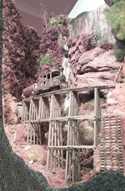
A 1/2 mile or so down the tramway, we come to the
picturesque crossing over Broughton Creek. The trestle here was scratchbuilt
from scale stripwood, and detailed with NBW castings and styrene. Around 95%
of the scenery you see in this photo is natural materials, as is the rest of
the layout. This use of lichens, ferns, and other small plants, combined with
a foam base, and "soft rocks", makes for an easy, economical, and
light weight way to build scenery. In this scene there are many details, such
as a fisherman and his dog, two koalas, and a Thylacine or Tasmanian Tiger.
At the top of the falls, there is a mirror which bends the scene around to the
left.
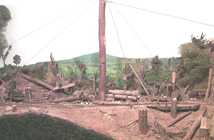 After
around another 1/2 mile, we come to one of the log loading areas perched on
the wall of the Great Dividing Range, known as Woodhill Mountain. Hard at
work are two scratchbuilt steam donkeys, one yarder running the high lead,
and the loader swinging those big logs from the log deck onto the tiny disconnect
cars. The Spar tree is rigged with white metal Rio Grande pulleys and treated
and weathered cotton thread. All of the track on the layout is PECO code 80
N scale. The switches are medium radius N scale units, while all other track
is handlaid with rail stripped from lengths of flextrack. The horses in this
scene are Clydesdales produced in metal by Kerroby Models.
After
around another 1/2 mile, we come to one of the log loading areas perched on
the wall of the Great Dividing Range, known as Woodhill Mountain. Hard at
work are two scratchbuilt steam donkeys, one yarder running the high lead,
and the loader swinging those big logs from the log deck onto the tiny disconnect
cars. The Spar tree is rigged with white metal Rio Grande pulleys and treated
and weathered cotton thread. All of the track on the layout is PECO code 80
N scale. The switches are medium radius N scale units, while all other track
is handlaid with rail stripped from lengths of flextrack. The horses in this
scene are Clydesdales produced in metal by Kerroby Models.
Read
more about the building of Broughton Vale Tramway Who
is Broughton Vale?
Quick history of Broughton Vale What
is The Mission?